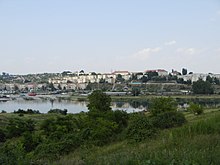Cernavoda
| Cernavoda | ||||
|
||||
| Basic data | ||||
|---|---|---|---|---|
| State : |
|
|||
| Historical region : | Dobruja | |||
| Circle : | Constanța | |||
| Coordinates : | 44 ° 20 ' N , 28 ° 2' E | |||
| Time zone : | EET ( UTC +2) | |||
| Height : | 50 m | |||
| Area : | 46.69 km² | |||
| Residents : | 17,022 (October 20, 2011) | |||
| Population density : | 365 inhabitants per km² | |||
| Postal code : | 905200 | |||
| Telephone code : | (+40) 02 41 | |||
| License plate : | CT | |||
| Structure and administration (as of 2016) | ||||
| Community type : | city | |||
| Mayor : | Liviu-Cristian Negoiță ( PNL ) | |||
| Postal address : | Str Ovidiu nr. 11 loc. Cernavodă, jud. Constanța, RO-905200 |
|||
| Website : | ||||
Cernavodă ( ) is a town in Romania in the Dobruja region , Constanța county . Cernavodă has approx. 17,000 inhabitants (2011) and is located on the Danube at the beginning of the Danube-Black Sea Canal . The name of the city is derived from the Bulgarian черна вода (Tscherna woda) , which means "black water".
location
The city is connected to the Romanian A2 motorway between Bucharest and Constanța . The Cernavodă nuclear power plant is the only nuclear power plant in Romania. Between 1890 and 1895, the first railway bridge over the Danube was built according to plans by the engineer Anghel Saligny , which at the time was the longest bridge in Europe at more than four kilometers. It was initially named Carol I Bridge after the Romanian ruler, later it was named after the engineer: Anghel-Saligny Bridge .
history
The city is where the characteristic terracottas of the Hamangia culture (4800-4300 BC) were found and the namesake of the later Cernavodă culture (4000-3200 BC).
In ancient times the city of Axiopolis ( Greek Ἀξιούπολις ) existed here , which led on the Danube route from Troesmis via Durostolum and Novae to Viminatium and Sirmium . The Via Pontica ran nearby . The original Dacian name of the city was Axíopa , it also means "black water".
literature
- Dinu Adameşteanu: Herakleia, later Axiopolis (Cernavodă) SE Romania . In: Richard Stillwell et al. a. (Ed.): The Princeton Encyclopedia of Classical Sites. Princeton University Press, Princeton NJ 1976, ISBN 0-691-03542-3 .
Web links
Individual evidence
- ↑ 2011 census in Romania at citypopulation.de
- ↑ Ian Shaw, Robert Jameson (Ed.): A dictionary of archeology. Blackwell, Oxford 2002, ISBN 0-631-23583-3 , p. 267.
- ^ Map: Balkans, 6th century
- ↑ James P. Mallory , Douglas Q. Adams (Ed.): Encyclopedia of Indo-European Culture. Fitzroy Dearborn, London et al. 1997, ISBN 1-88496-498-2 , pp. 145-146.



